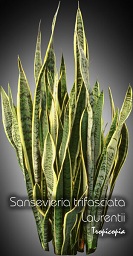Table of contents
Snake plant

Latin Name: Sansevieria trifasciata Laurentii
Category: Sansevieria
Family: Liliaceae
Origin: South Africa
Climate: Tropical
Growing Zones: 11-10
Care Instructions
The Snake plant (Sansevieria trifasciata Laurentii) is a tropical plant that originates from South Africa. This sansevieria plant belongs to the Liliaceae family and is well-suited for growing in USDA zones 11-10.
Complete Care Guide for Snake Plant (Sansevieria trifasciata Laurentii)
Watering Requirements
The Snake Plant, also known as Sansevieria trifasciata Laurentii, is renowned for its resilience and low maintenance needs, particularly when it comes to watering. This hardy succulent thrives in dry conditions, making it essential to avoid overwatering. Water the plant only when the top 1-2 inches of soil feel dry to the touch. During the growing season (spring and summer), a bi-weekly watering schedule is typically sufficient, while in the dormant months (fall and winter), you can reduce watering to once a month or even less. Always ensure that the pot has drainage holes to prevent water from accumulating at the bottom, which can lead to root rot.
Light Conditions
Snake Plants are incredibly versatile when it comes to light conditions. They can thrive in a range of lighting environments, from low light to bright, indirect sunlight. However, for optimal growth, it is best to place them in bright, indirect light. Direct sunlight can scorch the leaves, while too little light can hinder their growth and lead to leggy, weak plants. If you notice the leaves starting to bend or lose their vibrant color, it may be a sign that they need more light. Rotate the plant occasionally to ensure even growth and prevent it from leaning towards the light source.
Soil Preferences
When it comes to soil, Snake Plants prefer a well-draining potting mix. A cactus or succulent mix is ideal, as it allows excess moisture to escape while retaining some necessary nutrients. If you want to create your own mix, combine regular potting soil with sand or perlite to enhance drainage. Fertilization is not a strict requirement for Snake Plants, but if you wish to promote growth, you can apply a balanced, diluted liquid fertilizer during the growing season, approximately once a month. Be cautious not to over-fertilize, as this can lead to salt buildup in the soil, which can harm the plant.
Pests and Diseases
While Snake Plants are generally resistant to pests and diseases, they can occasionally fall victim to common houseplant pests such as spider mites, mealybugs, and scale. To identify these pests, look for webbing, sticky residue, or small cotton-like clusters on the leaves. If you notice any signs of infestation, treat the plant with insecticidal soap or neem oil, ensuring to cover both the tops and undersides of the leaves. Additionally, be vigilant for signs of root rot, which can occur if the plant is overwatered. Symptoms include yellowing leaves and a mushy base. If you suspect root rot, remove the plant from its pot, trim away any affected roots, and repot it in fresh, dry soil.
Special Care Tips
To keep your Snake Plant thriving, consider a few special care tips. First, avoid placing the plant in drafty areas or near heating vents, as sudden temperature changes can stress the plant. Snake Plants prefer temperatures between 60°F and 80°F (15°C to 27°C). Additionally, wipe the leaves occasionally with a damp cloth to remove dust and enhance photosynthesis. This also helps to keep the plant looking its best. If you notice that your Snake Plant is becoming too large for its pot, consider repotting it every 2-3 years to refresh the soil and provide more space for growth. Lastly, while Snake Plants are generally safe, they are mildly toxic to pets if ingested, so keep them out of reach of curious animals.








